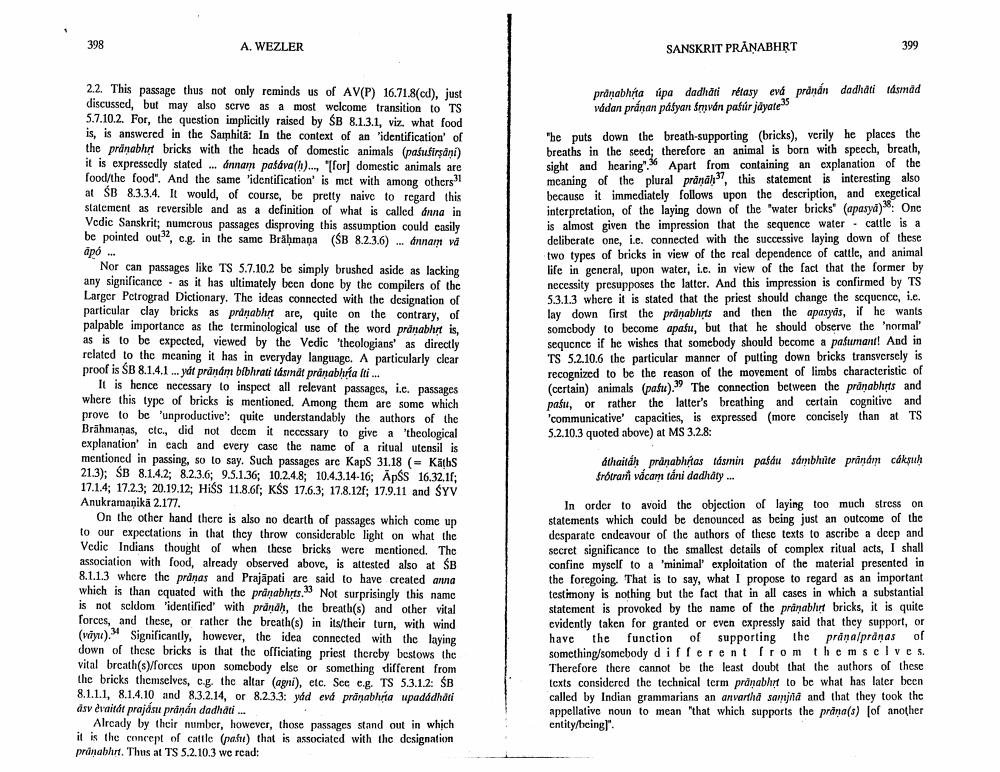________________
398
A. WEZLER
SANSKRIT PRANABHRT
399
pránán
dadhäti tasmad
prånabhíta úpa dadhati rétasyevá vadan pránan páfyan Srván pafür jdyate
2.2. This passage thus not only reminds us of AV(P) 16.71.8(cd), just discussed, but may also serve as a most welcome transition to TS 5.7.10.2. For, the question implicitly raised by SB 8.1.3.1, viz. what food is, is answered in the Samhita: In the context of an 'identification of the prdnabhrt bricks with the heads of domestic animals (pasufirşani) it is expressedly stated... annam pasáva(h).... [for domestic animals are food/the food". And the same 'identification is met with among others." at SB 8.3.3.4. It would, of course, be pretty naive to regard this statement as reversible and as a definition of what is called anvia in Vedic Sanskrit; numerous passages disproving this assumption could easily be pointed out, c.g. in the same Brahmana (SB 8.2.3.6)... annan vd apó ...
Nor can passages like TS 5.7.10.2 be simply brushed aside as lacking any significance as it has ultimately been done by the compilers of the Larger Petrograd Dictionary. The ideas connected with the designation of particular clay bricks as prdnabhrt are, quite on the contrary, of palpable importance as the terminological use of the word prdnabhrt is, as is to be expected, viewed by the Vedic 'theologians' as directly related to the meaning it has in everyday language. A particularly clear proof is SB 8.1.4.1...yát prānám blbhrati tásındt pránabhrfa ti...
It is hence necessary to inspect all relevant passages, i.e. passages where this type of bricks is mentioned. Among them are some which prove to be 'unproductive': quite understandably the authors of the Brahmanas, ctc., did not dcem it necessary to give a 'theological explanation in each and every case the name of a ritual utensilis mentioned in passing, so to say. Such passages are Kaps 31.18 (- Käths 21.3); SB 8.1.4.2; 8.2.3.6; 9.5.1.36; 10.2.4.8; 10.4.3.14-16; ApSs 16.32.1f; 17.1.4; 17.2.3; 20.19.12; HISS 11.8.67; KśS 17.6.3; 17.8.12f; 17.9.11 and SYV Anukramanikā 2.177.
On the other hand there is also no dearth of passages which come up to our expectations in that they throw considerable light on what the Vedic Indians thought of when these bricks were mentioned. The association with food, already observed above, is attested also at SB 8.1.1.3 where the pränas and Prajāpati are said to have created anvia which is than cquated with the prdnabhurts." Not surprisingly this name is not seldom 'identified' with prānáh, the breath(s) and other vital forces, and these, or rather the breath(s) in its/their turn, with wind (viye). Significantly, however, the idea connected with the laying down of these bricks is that the officiating priest thereby bestows the vital breath(s)/forces upon somebody else or something different from the bricks themselves, cg, the altar (agni), etc. See eg. TS 5.3.1.2: ŚB 8.1.1.1, 8.1.4.10 and 8.3.2.14, or 8.2.3.3: yad eva prānabhría upadádhati asv dvaitat prajásu pránán dadhati...
Alrcadly by their number, however, those passages stand out in which it is the concept of cattle (rafue) that is associated with the designation prunabhrt. Thus at TS 5.2.10.3 we read:
"he puts down the breath-supporting (bricks) verily he places the breaths in the seed; therefore an animal is born with speech, breath, sight and hearing". Apart from containing an explanation of the meaning of the plural pránál, this statement is interesting also because it immediately follows upon the description, and exegetical interpretation, of the laying down of the "water bricks' (apasya). One is almost given the impression that the sequence water . cattle is a deliberate one, i.e. connected with the successive laying down of these two types of bricks in view of the real dependence of cattle, and animal life in general, upon water, i.e. in view of the fact that the former by necessity presupposes the latter. And this impression is confirmed by TS 5.3.1.3 where it is stated that the priest should change the sequence, i.e. lay down first the pránabhirts and then the apasyvis, if he wants somebody to become apafu, but that he should observe the 'normal' sequence if he wishes that somebody should become a pafumani! And in TS 5.2.10.6 the particular manner of putting down bricks transversely is recognized to be the reason of the movement of limbs characteristic of (certain) animals (pasu)." The connection between the pränabhurts and pasul, or rather the latter's breathing and certain cognitive and 'communicative capacities, is expressed (more concisely than at TS 5.2.10.3 quoted above) at MS 3.2.8:
athaith pránabhtas tásmin frótrari vācam tani dadhâty ...
pafáu sámblite prändm
cáksuh
In order to avoid the objection of laying too much stress on statements which could be denounced as being just an outcome of the desparate endeavour of the authors of these texts to ascribe a deep and secret significance to the smallest details of complex ritual acts, I shall confine myself to a minimal exploitation of the material presented in the foregoing. That is to say, what I propose to regard as an important testimony is nothing but the fact that in all cases in which a substantial statement is provoked by the name of the pranablurt bricks, it is quite cvidently taken for granted or even expressly said that they support, or have the function of supporting the prana/prdnas of something somebody different from themselves. Therefore there cannot be the least doubt that the authors of these texts considered the technical term pranabht to be what has later been called by Indian grammarians an anvartha samjha and that they took the appellative noun to mean that which supports the prana(s) for another entity/bcing)"




